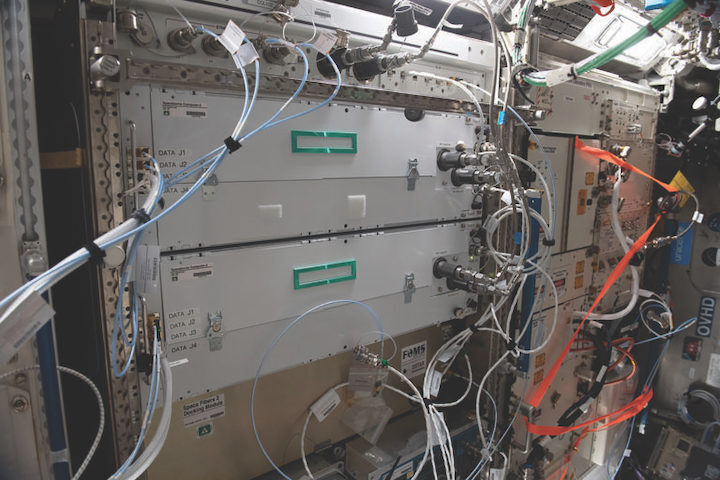6.04.2022

COLORADO SPRINGS – Hewlett Packard Enterprise, Microsoft and NASA will share details at the 37th Space Symposium on 24 research experiments completed to date on the International Space Station’s HPE Spaceborne Computer-2, including analysis of astronaut gloves that relies on artificial intelligence.
Since the Spaceborne Computer-2 was installed in ISS in May 2021, HPE has been working with Microsoft and NASA to demonstrate a variety of applications. Experiments conducted to date have focused on astronaut healthcare, image processing, natural disasters, 3D printing and 5G communications.
The astronaut glove experiment relies on artificial intelligence to analyze photos and videos of the gloves astronauts wear when repairing equipment and installing instruments outside ISS. NASA and Microsoft developed a glove-analyzer AI model that looks for signs of glove damage. When damage is detected, an annotated image is sent automatically to Earth for further review.
“By introducing edge computing and AI capabilities to the International Space Station with Spaceborne Computer-2, we have helped foster a growing, collaborative research community that shares a common goal to make scientific and engineering breakthroughs that benefit humankind, in space and here on Earth,” Mark Fernandez, HPE Spaceborne Computer-2 principal investigator, said in a statement.
Edge processing will become increasingly important for human space exploration because astronauts traveling to the moon, Mars and other deep space destinations will experience communications delays. If used wisely, AI, cloud computing and space-based edge processors could eliminate the need for astronauts to constantly send information to the ground for processing and analysis.
Another widely discussed experiment looks for mutations in astronaut DNA. Prior to the Spaceborne Computer-2, sending a 1.8 gigabit raw DNA sequence took more than 12 hours to deliver the data to researchers on the ground for processing. Now, the data can be processed on the space station in six minutes, compressed and sent to Earth in two seconds, according to an HPE April 4 news release.
The Spaceborne Computer-2 also is being used to test automatic interpretation of satellite imagery. NASA Jet Propulsion Laboratory researchers use a type of artificial intelligence called deep learning to automatically interpret data captured in orbit of land and structures after disasters like floods and hurricanes.
Another experiment by the Cornell University Fracture Group tested modeling software that simulates 3D printing of metal parts and predicts failure or deformation that could result. Tests on the Spaceborne Computer-2 validated the software.
Mobile network operator Cumucore tested various features of its 5G core network on Spaceborne Computer-2. The experiment indicated that installing 5G equipment on some satellites and spacecraft could enhance space-based communications.
The Spaceborne Computer-2, which HPE sent to orbit in February 2021 in a Northrop Grumman Cygnus capsule in collaboration with the ISS National Laboratory, is expected to remain on ISS for approximately two more years.
Quelle: SN
